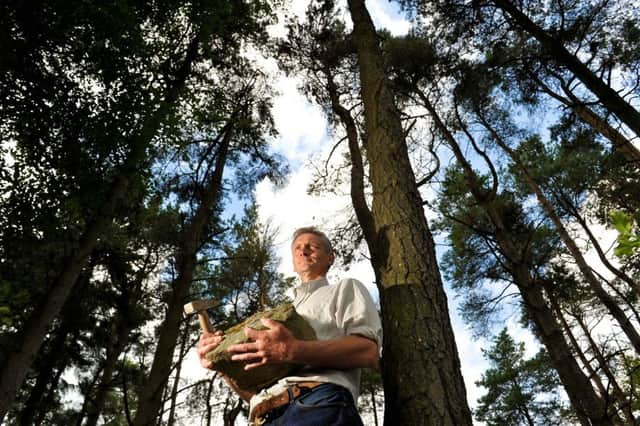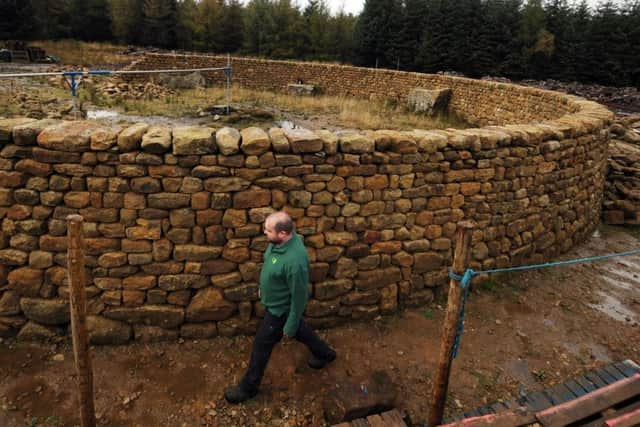Dry stone circle: Lost art of the labyrinth


This colossal structure is not a Neolithic monument, but Yorkshire’s newest land art project, the Dry Stone Wall Maze in Dalby Forest. When complete, it will be the largest dry stone wall construction in the world, incorporating more than 4,000 tonnes of largely reclaimed stone. For now though, much of the structure exists only in the imagination of Mark Ellis, the Farndale-based dry stone specialist who has nurtured this grand idea for almost 20 years. His dream has now begun a slow transformation into reality with the help of Ryedale District Council, the Friends of Dalby Forest, the Forestry Commission and sculptor Jennifer Tetlow.
Mark’s ambition is to create a piece of land art that celebrates the technique and heritage of dry stone walling while engaging a new generation. In part, it will be a showcase. “If you drive around the moors or the dales you’re bound to see walls,” says Petra Young, of the Forestry Commission. “You might even see one or two special features, but here visitors will be able to come and see them all in one place, touch them and understand how they were made and what they’re for.”
Advertisement
Hide AdAdvertisement
Hide AdThe art of building stone walls without mortar is thousands of years old, and developed in many places where suitable building stone was readily available and people had need of barriers and boundaries. The technique originally made use of stones collected on site and moved a short distance to the edge of the field. Ingenuity was essential in fitting these variously shaped pieces together securely. The integrity of the walls relies on skilful interlocking, so the weight of the wall is spread evenly and the structure doesn’t become top heavy or unstable. Ancient examples are known as far away as Peru, and European methods were introduced anywhere settlers found suitable landscape, including North America and New Zealand. In Britain, dry stone walls have become the upland counterparts of hedgerows, ideally suited to places where thin soils and exposed conditions mean hedges are unlikely to establish themselves easily or become dense enough to be stockproof. Regional styles have developed as result of differences in the stone used and of techniques refined over centuries by generations of wallers, many of whom work the same patch for a lifetime.


The project is being largely funded by public donations. You can pay for a stone, or buy a block carved with your initials or those of a loved one. Or you can join a stone carving workshop and inscribe a stone yourself. The hands- on approach appealed to me, so I signed up for a family session with Jennifer Tetlow.
Our first sight of the maze was on a flawless morning in April. At this point, the first stone circle was partially complete – a horseshoe of honeyed stone, slightly more than head high, in the centre of a vast clearing at the highest point of the forest. Standing in the circle, I could hear birdsong from the surrounding ranks of spruce. There was another sound too, almost as old as humanity itself. The steady chip chip chip of tools on stone.
The implements Jennifer had laid out for us on wooden benches would have been immediately recognisable to a Bronze Age craftsman. A large chisel, a small chisel and a dummy mallet. We were invited to select a block from the piles heaped around the site and use carbon paper to transpose beautiful serifed initials onto its surface.
Advertisement
Hide AdAdvertisement
Hide AdStone carving might not be the first craft you think about teaching a five-year-old, but we had one with us. To her credit, Jennifer was entirely unfazed and set about demonstrating how to chip into the corners of each letter with a small chisel and carve the midline of each letter stroke as straight and sharp as the edge of a page. Then it was our turn. My first thought was how straightforward it was – with each blow of the mallet, the chisel bit easily into the stone. Perhaps a little too easily. My second thought was how easy it was to go wrong. Not massively wrong, but just enough to wish I could do it again.


But with stone, every mark is a done deal – you can’t unmake it. And so with my enthusiasm tempered, I progressed more carefully, opening out the strokes little by little and trying to stay within the carbon lines. I realised I was holding my breath as I got close to each edge. Tap tap tap. There was something mesmeric about the sound and the sensation. I felt I had done this before, though I certainly haven’t.
Meanwhile my son was bashing happily away at his own block, making his mark and drawing butterflies for later carving. After a couple of hours we had done a respectable job, our midlines a little soft and wobbly compared with Jenifer’s crisply defined ones, but until that April day I’d never looked at carved lettering closely enough to notice how the fall of light shows up every wobble.
I visited the maze again in October, on another glorious day. The site still has the feeling of an arena, roofed in by sky the same shade of blue as the Yorkshire flag, but the maze has grown – it now comprises one and a half circles. The scale of the project is becoming apparent, with the walkways between the walls cart-track wide. I find the family block that we carved in situ, along with many others.
Advertisement
Hide AdAdvertisement
Hide Ad“It’s a snapshot of people’s lives,” says Laleh Hobbs, of the Forestry Commission. “We’re not doing dates or memorials or anything like that – and we won’t be taking stones out if couples divorce.” It’s a good point. Have they considered that people might try to add their own unofficial marks? “I have,” adds Mark. “Wherever there’s stone and a means to mark it, people have always done that. I want people to be part of what we’re building.”
More stone is still arriving from all over the area – some looks fresh, but several of the heaps include stone that is weathered or shaped from previous use. The maze is expected to take three years to complete, partly because of its scale, partly because Mark is fitting in the work alongside his regular job and partly because the project is largely funded by members of the public paying stone by stone. But when you’re talking stone circles, time seems a minor consideration. There’s something epic and satisfying about this slow-burn, non-prescribed approach. The result is likely to be a heartfelt and lasting homage not only to an ancient art, but also to the uniquely human urge to leave a lasting mark.
To find out more about the Dalby Dry Stone Maze project, sign up for a workshop or buy a stone as a gift visit drystonewallmaze.com/